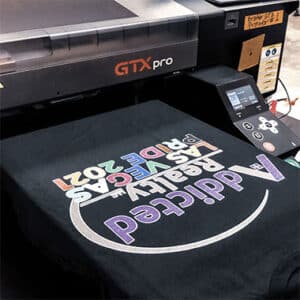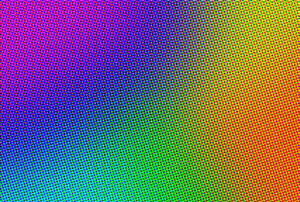Are you captivated by the vivid graphics on your favorite t-shirt or the detailed imagery in that beautiful brochure? Here’s the secret- it’s the proper implementation of digital printing concepts.
Let us help you dive into the ins and outs of digital printing, its benefits, and how you can leverage it for your needs in the sections to follow.
What is Digital Printing?
Digital printing is a method of printing that utilizes digital files instead of plates or screens, directly transferring the design to various materials. It revolutionized the print industry by offering a flexible and quick solution for those seeking high-quality prints in smaller quantities.
Its ability to reproduce a design with precision sets digital printing apart, maintaining the same high resolution and color consistency in every print.
How Does Digital Printing Work?
In digital printing, an image is sent directly to the printer using digital files such as PDFs or other desktop publishing software. This differs substantially from traditional printing methods, such as lithography or flexography, which require physical plates to transfer images.
The image is broken down into tiny pixels or dots and is reproduced on the printing surface. The new printing technology uses electrostatic rollers, known as “drums,” to apply toner onto the material, which is then fused onto the surface by heat and pressure. This process can be used for various materials, including paper, canvas, fabric, and ceramics.
Digital printing on fabric has opened a world of possibilities for designers, allowing them to express their creativity on various textiles, from cotton to polyester, without worrying about color limitations or intricate design details.
Screen Print vs. Embroidery

The choice between screen print vs embroidery often depends on the desired outcome and the nature of the design.
Screen printing is an excellent choice for larger orders with simple designs, offering a cost-effective option. However, it can be limited in its ability to handle complex, multi-colored designs.
On the other hand, embroidery provides a high-end finish, especially for apparel. It gives a three-dimensional feel, adding texture and depth. Yet, it’s more suitable for small designs due to cost and production time considerations.
Digital printing shines through for intricate and detailed designs, regardless of color count. It directly transfers the digital image onto the material, allowing for high-resolution outputs and precise color matching.
Types of Digital Printing
There are several types of digital printing to meet various needs:
- Inkjet Printing: This method sprays tiny ink droplets onto the material’s surface. It is versatile and can handle various materials, including paper, canvas, and textiles.
- Laser Printing: Laser printing uses a laser beam to produce an image. It’s fast, efficient, and ideal for high-volume print jobs.
- Dye-Sublimation: This technique is primarily used for printing on fabric. It heats the ink until it becomes gas, permeating the fabric’s fibers and producing vibrant and long-lasting colors.
- Direct-to-Garment (DTG): Finally, this technique prints directly onto textiles, making it perfect for T-shirts and other apparel.
Benefits of Digital Printing
- High Quality: Digital printing offers excellent print quality, delivering high resolution and precision in each print.
- Speed and Efficiency: This fast and efficient process makes it an excellent choice for projects requiring a quick turnaround or short-run prints.
- Cost-Effective for Small Batches: Without plates, the setup cost for digital printing is lower, making it cost-effective for small-quantity print jobs.
- Versatility: This method is adaptable to various surfaces, including paper, cardstock, fabric, and ceramics, providing a broad range of possibilities for businesses and creatives.
- Detailed Design Accommodation: It can also handle intricate designs and multiple colors well, which can be challenging for other print methods.
- Customization: With digital files guiding the printing process, design, color, or size alterations can be made without an extensive overhaul of the printing setup, allowing for easy customization.
Drawbacks of Digital Prints
Despite the numerous benefits, digital printing has drawbacks.
The first is cost-related; traditional methods like offset printing may be more cost-effective for large-scale print jobs due to lower per-unit costs over high volumes.
Additionally, printing on fabric may offer a different level of ‘hand’ or feel that traditional screen printing provides, which might be a critical factor for some textile applications.
Another potential downside is color limitations. Digital printers typically use a standard four-color process (CMYK), which may not match all Pantone colors accurately. This could affect brands with strict corporate color guidelines.
Digital printing Inks
The type of ink used in digital printing technology significantly impacts the final product’s quality and appearance. Two primary types of ink are used in digital printing: dye and pigment-based ink.
Dye-based inks deliver vibrant colors and smoother gradients, making them ideal for high-quality photo prints. However, they are less resistant to fading and can be affected by environmental factors like sunlight or moisture.
On the other hand, pigment-based inks are more durable and resistant to environmental conditions. They provide sharp, crisp images, which makes them well-suited for text-based prints or fine art reproductions.
CMYK vs. RGB
Understanding the difference between CMYK and RGB color models is crucial in digital printing.
RGB (Red, Green, Blue) is a color model for digital displays, such as computer screens and televisions. It’s an additive model, which means colors are created by combining light.
On the other hand, CMYK (Cyan, Magenta, Yellow, Black) is a subtractive model used in color printing. Unlike RGB, where colors are created by adding light, in CMYK, colors are formed by subtracting or absorbing light.
Therefore, when preparing a design for a digital printing service, it’s essential to use the CMYK color mode to ensure the colors on the printed material match your original design as closely as possible.
Digital Print Media and Products
One of the most significant advantages of digital printing is its versatility in the types of media and products it can produce. You can use digital printing to create various marketing materials, including brochures, business cards, flyers, and banner printing materials. It’s also widely used in producing books, magazines, and catalogs.
Digital print technology also allows printing on various substrates beyond paper, like vinyl, acrylic, canvas, metal, and fabric. This capability opens up possibilities for unique products such as a custom team shirt, promotional items, interior decor, and more.
Digital Printing vs. Offset Printing
One of the most common comparisons in the print industry is between digital and offset printing. While both have merits, the choice ultimately depends on the project’s requirements.
Offset printing involves transferring an image from a plate to a rubber blanket and then onto the printing surface. While it has a higher initial setup cost and longer lead time, it offers a lower cost per unit for large quantities, making it an excellent choice for high-volume print jobs.
In contrast, digital printing shines in terms of customization and a faster turnaround time. It doesn’t require any plates, allowing for a quicker setup and the ability to start printing almost immediately. This feature makes printing more suitable for personalized prints or jobs requiring a quick turnaround.
Understanding digital printing, its benefits, and its limitations can help you choose the best printing methods for your specific needs.
Table of Contents
table
Recent Blogs

A Guide to Onboarding New Employees

The Best Ideas for Work Anniversary Gifts

Let’s Socialize
Never Miss a Thing
Subscribe to our newsletter and stay updated to our offers and deals!

